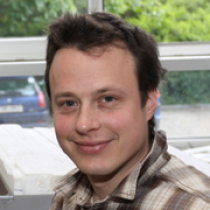CLR person interests, research and publications
Researcher

I am mainly interested in mechanisms of vertical transfer and associated fabric transpositions of rocks in the lithosphere. The aim of his recent work is to constrain the dynamics of deformation and melt transfer associated with subduction and exhumation of the crust during collision of the continents. The field areas for this research are the Variscan Bohemian Massif and the Himalayan mountain range in India. His research also comprises the mechanisms of magma ascent in the plumbing systems below the volcanoes and salt tectonics in the Zagros Mountains in Iran. To tackle these dynamic systems, Prokop combines the field structural mapping with microstructural analysis and physical modeling.
Education
- Ph.D. Structural Geology, Charles University in Prague (2003–2007), Ph.D. thesis title: “Mechanisms of flow and fabric development in rocks with low melt content”
- Msc. Structural Geology, Charles University in Prague (1998–2003), Msc. thesis title: “Quartz and Feldspar rheology contrasts under natural thermal and strain gradients: a comparative study of deformation and microstructures”
Awards
- O. Wichterle prize for excellent young researchers of the Czech Academy of Sciences (2014)
- Radek Melka award from the CETeG committee for best scientific paper of young scientists (1st author) (2012)
- Radek Melka award from the CETeG committee for best scientific paper of young scientists (1st author) (2008)
- Radek Melka award from the CETeG committee for best scientific paper of young scientists (2nd author) (2007)
- Best poster presentation, Klášter Teplá, Czech Republic (2007)
- Best student oral presentation, CETeG, Poland (2006)
- Best student oral presentation, TSG conference, Durham, Great Britain (2004)
- Best poster presentation, CETeG conference, Slovakia (2004)
Professional experience
- 2012-2013 (3 months): Deutsche Akademischer Austausch Dienst (DAAD), Lehr- und Forschungsgebiet für Geologie – Endogene Dynamik, Aachen, Germany
- 2009 (6 months): DAAD, Lehr- und Forschungsgebiet für Geologie – Endogene Dynamik, Aachen, Germany
- 2006 (3 months): Scholarship funded by the french government, Université Louis Pasteur (EOST), Strasbourg, France
- 2005 (4 months): Erasmus scholarship, Hans Ramberg Tectonic Laboratory (HRTL), Uppsala, Sweden
Research projects
The granulite-gneiss extrusions in the Bohemian Massif are interpreted as parts of the lower plate, subducted, relaminated below the upper plate and exhumed as kilometre-scale translithospheric diapirs through upper plate. Because dominated by metagranites, it is repeatedly stated that they originated from continent subduction. Many studies were dedicated to their tectono-metamorphic Variscan evolution. Almost missing are studies trying to understand their paleo-environment that allowed such unprecedented travel of rocks through mantle.
Melt migration is the key process transferring mass, heat and volatiles from the Earth’s depth towards the surface, and therefore shaping the chemical and thermal structure of the lithosphere. Common understanding of crustal melt migration is biased towards mechanisms that can be easily identified as they preserve macroscopic segregations of melt in outcrops, such as in dykes or leucosome-bearing migmatites. In contrast, recent observations show that micro-scale pervasive flow of melt along grain boundaries can affect significant portions of hot continental crust.
The growth of eastern Pangea involves three contrasting orogenic cycles: 1) Baikalian cycle (570-540 Ma) consists of accretion of peri-Rodinian continental, Mirovoi and Panthalassan oceanic fragments to the Siberian margin followed by extensional HT reworking, the growth of magmatic arc, giant accretionary wedge and intraoceanic basin. 2) Altai cycle is typified by crustal thickening followed by syn-extensional melting of the accretionary wedge (420-380 Ma) and the opening of Mongol-Okhotsk ocean.
